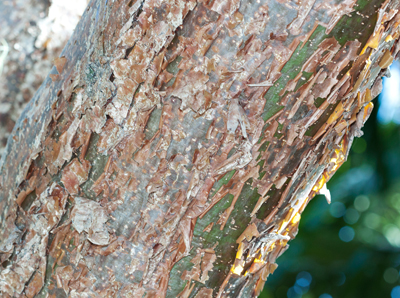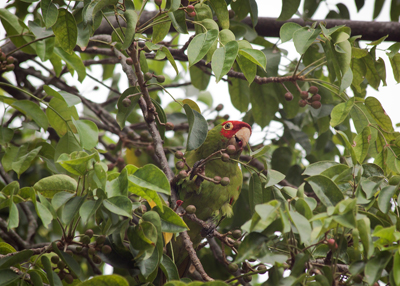The humble gumbo limbo

BY KENNETH SETZER
As published in the Miami Herald, 1/17/15.
It’s easy to dismiss that which is all around us, but ask anyone from outside South Florida what a gumbo limbo is, and chances are they’ll think it’s a Cajun soup. Gumbo limbo, though a common tree in most South Florida neighborhoods, is one of the most important members of our hammock ecosystem, and one with an interesting tale to tell.
Gumbo limbo (Bursera simaruba) belongs to a family of mostly tropical trees, with gumbo limbo found in northern South America, the Caribbean and in its northernmost range here in Southeast Florida. It can grow to about 50 feet or more. Stocky, older individuals develop a massive trunk several feet in diameter that swells after lots of rain, three or four thick lower limbs, and a canopy nearly as wide as the tree is tall.
Gumbo limbos are semi-evergreen, regenerating leaves seasonally or during drought conditions. It may seem odd to see a bare tree in South Florida, but this is normal for the gumbo limbo in late fall or spring, and the leaf shedding is usually not complete.
The gumbo limbo’s flowers grow abundantly along panicles, but are small, greenish and inconspicuous. Flowers may appear all year, and though not necessarily attractive to us, bees rely on them as an important food source. Their fruit, however, is much more showy, and equally important for wildlife. The small red berries appear in clusters and are an important food for many birds including winter migrants, not to mention squirrels. Gumbo limbo is also a larval host plant for dingy purplewing (Eunica monima) butterflies.
Gumbo limbo bark is my favorite aspect of the tree. It’s a coppery or deep red, and looks polished, glossy, like it’s been varnished. It peels off like sheets of the mineral mica, revealing the glabrous, grayish green bark beneath. Peeling pieces of bark catch the raking afternoon light in fall and winter, and absolutely light up.
Gumbo limbo wood is really quite soft. It’s said to have been carved to make carousel horses when such things were actually crafted from wood. I have carved it, and it can be unreliable in consistency and too soft to hold details without breaking. It is an attractive creamy pale white wood with very little grain.
Gumbo limbo propagation is best done by seed. In parts of the Caribbean, “living fences” are sometimes made by planting limbs of gumbo limbo in rows directly into the soil, since cuttings root very easily and grow quickly. I once had a small limb placed on my concrete patio in complete shade, and it sprouted without soil or water!
Some researchers claim that trees grown from seed survive hurricane winds more often than those grown from cuttings.
Gumbo limbo obviously thrives in our poor, alkaline soil. While it won’t tolerate long-term saltwater inundation, it does have a moderate tolerance to salt air, so it makes a great coastal tree. Once established, it requires no irrigation at all, nor additional nutrition. It’s a good candidate for habitat restoration because it is fast growing (though non-invasive) and can tolerate most soil types.
The gumbo limbo belongs to the Burseraceae family, aka the torchwood or frankincense family — one with loads of ethnobotanical, medicinal and cultural uses. I won’t go into the medicinal practices, but will say that different parts of these trees — resin, sap, leaves, bark, fruit, wood and their various extracts —have been used to treat inflammation, parasites, digestive issues and just about everything else. Native Americans and Caribbeans have used the sticky gumbo limbo bark resin as bird lime, a sort of sticky trap to capture birds. The resin has also been employed in varnishes and glue.
The family Burseraceae has a long history, indeed prehistory, involving its resin and human cultures. It’s been valued as incense by pre-Columbian, Mesoamerican cultures for centuries.
Though immune to most pests, the gumbo limbo was recently a favorite of the rugose spiraling whitefly (Aleurodicus rugioperculatus). The whitefly’s honeydew excretion causes the sooty black mold that stains sidewalks, patios, cars and anything under the affected trees. Natural predators seem to have reduced this whitefly, though it can still be found feeding from gumbo limbo, so avoid planting the tree near pools, driveways or patios that may suffer from staining.

A mature gumbo limbo tree

Characteristic peeling bark of the gumbo limbo, called the tourist tree

A red masked parakeet (Psittacara erythrogenys) feeding on gumbo limbo fruit
